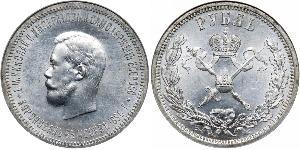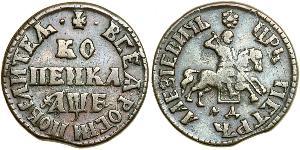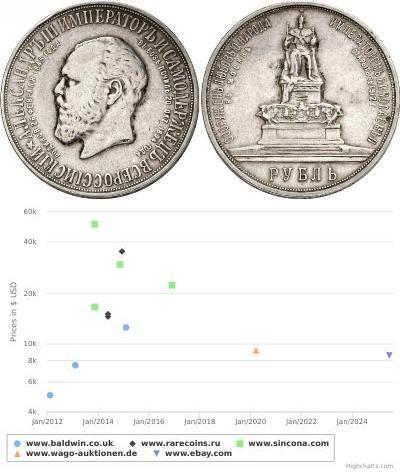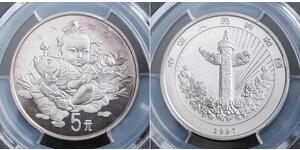25 Kopeck (售价 $46.0)
1859, Russia, Emperor Alexander II. Silver 25 Kopeks Coin. Corroded & Cleaned!
Mint Year: 1859
Reference: KM-C#23.
Mint Place: St. Petersburg (S.P.B.)
Denomination: 25 Kopeks (1/4 Rouble)
Condition: Corrosion scars (environmental damage), definitely cleaned, othewrise VF+
Material: Silver (.868)
Diameter: 24mm
Weight: 5.16gm
AlexanderII of Russia (Aleksandr II Nikolaevich) (29 April [O.S. 17 April] 1818, Moscow – 13 March [O.S. 1 March] 1881, Saint Petersburg), also known as Alexander the Liberator (Russian: Aleksandr Osvoboditel') was the Emperor, or Czar, of the Russian Empire from 3 March 1855 until his assassination in 1881. He was also the King of Poland and the Grand Duke of Finland.
Alexander II succeeded to the throne upon the death of his father in 1855. The first year of his reign was devoted to the prosecution of the Crimean War and, after the fall of Sevastopol, to negotiations for peace, led by his trusted counsellor Prince Gorchakov. It was widely thought[who?] that the country had been exhausted and humiliated by the war. Encouraged by public opinion he began a period of radical reforms, including an attempt to not to depend on a landed aristocracy controlling the poor, a move to developing Russia's natural resources and to thoroughly reform all branches of the administration.
After Alexander became tsar in 1855, he maintained a generally liberal course. Despite this he was a target for numerous assassination attempts (1866, 1879, 1880). On March 13 [O.S. March 1] 1881 members of the Narodnaya Volya (People's Will) party killed him with a bomb. The tsar had earlier in the day signed the Loris-Melikov constitution which would have created two legislative commissions made up of indirectly elected representatives, had it not been repealed by his reactionary successor Alexander III.
In spite of his obstinacy in playing the Russian autocrat, Alexander II acted for several years somewhat like a constitutional sovereign of the continental type. Soon after the conclusion of peace, important changes were made in legislation concerning industry and commerce, and the new freedom thus afforded produced a large number of limited liability companies. Plans were formed for building a great network of railways—partly for the purpose of developing the natural resources of the country, and partly for the purpose of increasing its power for defence and attack.
The existence of serfdom was tackled boldly, taking advantage of a petition presented by the Polish landed proprietors of the Lithuanian provinces and, hoping that their relations with the serfs might be regulated in a more satisfactory way (meaning in a way more satisfactory for the proprietors), he authorized the formation of committees "for ameliorating the condition of the peasants", and laid down the principles on which the amelioration was to be effected.
This step was followed by one still more significant. Without consulting his ordinary advisers, Alexander ordered the Minister of the Interior to send a circular to the provincial governors of European Russia, containing a copy of the instructions forwarded to the governor-general of Lithuania, praising the supposed generous, patriotic intentions of the Lithuanian landed proprietors, and suggesting that perhaps the landed proprietors of other provinces might express a similar desire. The hint was taken: in all provinces where serfdom existed, emancipation committees were formed.
But the emancipation was not merely a humanitarian question capable of being solved instantaneously by imperial ukase. It contained very complicated problems, deeply affecting the economic, social and political future of the nation.
Alexander had to choose between the different measures recommended to him. Should the serfs become agricultural labourers dependent economically and administratively on the landlords, or should they be transformed into a class of independent communal proprietors?
The emperor gave his support to the latter project, and the Russian peasantry became one of the last groups of peasants in Europe to shake off serfdom.
The architects of the emancipation manifesto were Alexander's brother Konstantin, Yakov Rostovtsev, and Nikolay Milyutin.
On 3 March 1861, 6 years after his accession, the emancipation law was signed and published.
Army and navy reorganization and rearmament was initiated in response to the overwhelming defeat suffered by Russia in the Crimean War, and an awareness of military advances being implemented in other European countries. The changes included universal military conscription, the creation of an army reserve and the military district system (still in use a century later), the building of strategic railways, and an emphasis on the military education of the officer corps.
A new judicial administration based on the French model (1864), which introduced security of tenure; a new penal code and a greatly simplified system of civil and criminal procedure.
An elaborate scheme of local self-government (Zemstvo) for the rural districts (1864) and the large towns (1870), with elective assemblies possessing a restricted right of taxation, and a new rural and municipal police under the direction of the Minister of the Interior were instituted.

|
发布人:
anonymous 2024-07-16 |
|
||
|
||
|
||
|
||
|
||
40 coin descriptions were improved from 2025-05-21 to 2025-05-28
其中一个是:
5 Yuan 中华人民共和国 銀
本组有 2 钱币

-600-300-H1esHgTyC0gAAAGQAIXl1b3z.jpg)

-300-150-qSjBwcI0SU4AAAEr9IkjLZIM.jpg)
 Deutsch
Deutsch Русский
Русский Українська
Українська English
English Italiano
Italiano Français
Français Español
Español 汉语
汉语











